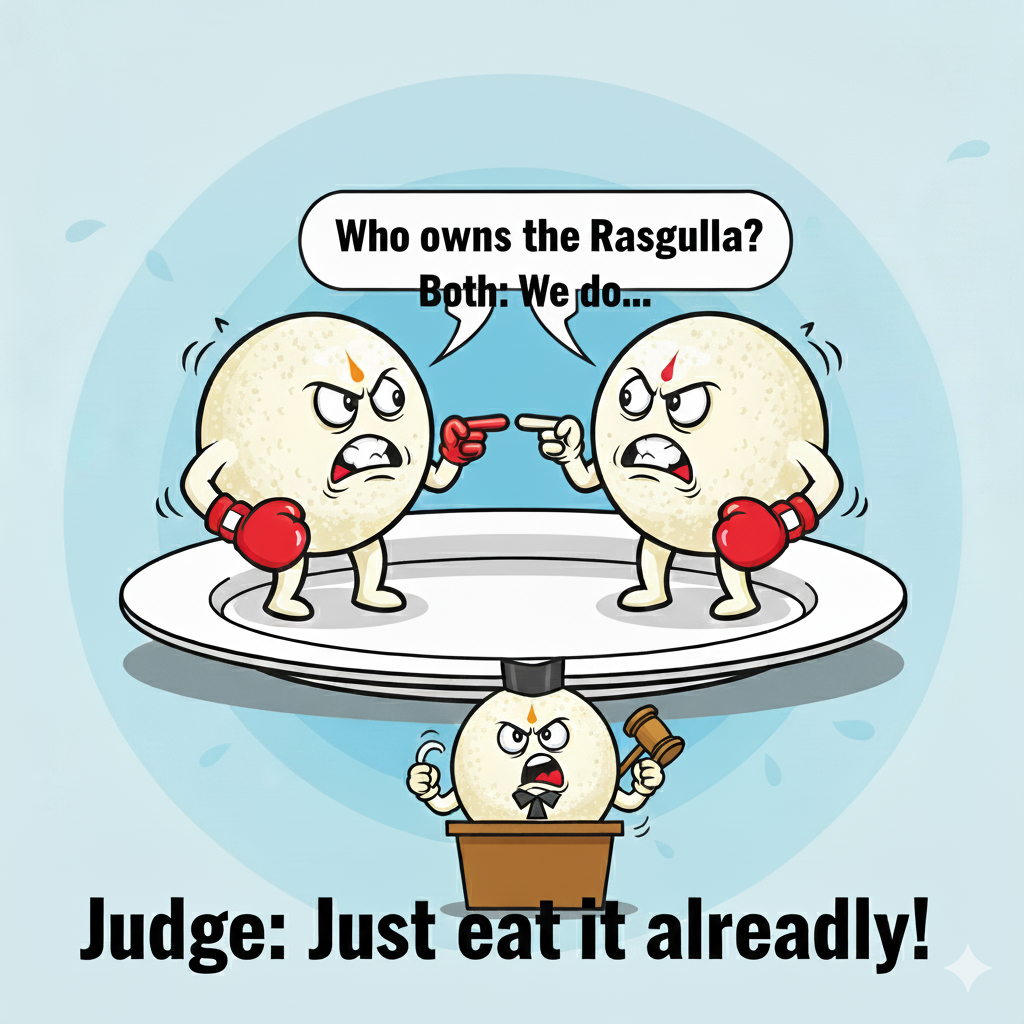When a beloved sweet becomes the focal point of a regional standoff, emotions are heightened, and heritage becomes paramount. This is exactly what unfolded with the Rasgulla- soft, syrupy ball of chhena (cottage cheese) soaked in sugar syrup—when both West Bengal and Odisha claimed it as their own culinary legacy. What might seem like a simple dessert quickly transformed into a matter of regional pride, cultural identity, and eventually, legal recognition. The dispute escalated all the way to India’s Geographical Indications (GI) Registry, drawing nationwide attention.
What is a Geographical Indication tag (GI)?
A Geographical Indication (GI) tag is more than just a legal label; it’s a mark of identity, heritage, and authenticity. It is given to products that come from a specific place and possess unique qualities, traditions, or a reputation linked to that region. Some of the known products in our knowledge are GI protected; for example, Darjeeling Tea, with its unmistakable aroma that instantly transports you to the misty hills of West Bengal; Banarasi Sarees, whose intricate handwoven designs tell centuries of Varanasi craftsmanship; or Mysore Silk, prized for its royal texture and luxurious sheen. These GI-tagged products are not just items; they are stories of culture, history, and community wrapped into a tangible experience.
But why are GI tags so important?
Firstly, they preserve culture and tradition, safeguarding skills and knowledge passed down through generations. Secondly, they bring economic benefits, giving local producers exclusive rights, boosting market value, and opening doors for tourism and global recognition. Thirdly, they act as a seal of authenticity, assuring consumers that they are getting the genuine article. And lastly, they prevent misuse or imitation, protecting both the product’s reputation and the livelihoods of the communities behind it.
The rasgulla controversy was therefore not a mere quarrel over a sweet; it was about preserving cultural history, protecting intellectual property, and securing the socio-economic benefits that come with GI recognition. The GI dispute became a test of how law intersects with culture and how something as seemingly simple as a dessert can turn into a battleground of pride, economy, and heritage conflict as layered and rich as the sweet itself.
Background and Legal Battle
In India, few sweets have sparked as much debate, passion, and legal attention as the beloved Rasgulla. This soft, syrupy dessert, adored across generations, became the centerpiece of a dispute that combined culinary tradition, religious heritage, and regional pride. The story begins in 2015, when the Odisha government formally initiated steps to claim Rasgulla as part of its cultural and culinary heritage. Odisha’s argument was deeply rooted in centuries-old traditions, particularly the Jagannath Temple rituals in Pahala village near Bhubaneswar, where rasgulla has been offered as a sacred prasad (offering) during the Niladri Bije ceremony, which marks Lord Jagannath’s return to the temple after the Rath Yatra. Scholars, temple authorities, and historians submitted ancient manuscripts, temple records, and oral testimonies, tracing the sweet back hundreds of years. Odisha’s Rasagola, known for its light, porous texture, delicate sweetness, and perfect syrup absorption, was portrayed not just as a dessert but as a spiritualand cultural emblem, linking generations of devotees and temple traditions.
In 2017, the Geographical Indications (GI) Registry of India granted West Bengal the GI tag for Banglar Rasogolla, recognizing it as a separate, region-specific version of the sweet. Bengal’s claim rested on documented historical evidence crediting Nobin Chandra Das, a pioneering 19th-century Kolkata confectioner, with popularizing the modern Rasogolla. His version, slightly firmer and denser, was meticulously boiled in sugar syrup to maintain consistency and shape, ideal for urban markets and commercial distribution. For West Bengal, Banglar Rasogolla became a symbol of culinary innovation, reflecting the state’s rich sweet-making traditions and entrepreneurial heritage.
The GI recognition of West Bengal’s variant ignited a dispute. Odisha argued that awarding the tag overlooked Rasgulla’s ancient temple-linked origins and century-old cultural significance. The debate transcended taste, touching upon heritage, identity, and regional pride. Both states presented historical documents, culinary records, and cultural narratives to substantiate their claims, emphasizing how preparation techniques, texture, sweetness, and context varied distinctly between the two regions.
After careful review, the GI Registry provided a balanced resolution, granting separate GI tags to both states for their respective versions. West Bengal received the GI tag in 2017 for “Banglar Rasogolla,” noted for its spongy texture and 19th-century culinary innovation. Odisha followed in 2019 with the GI tag for “Odisha Rasagola,” a softer, less sweet variant traditionally linked to sacred offerings at the Jagannath Temple. The Registry recognized that while the term “Rasgulla” is generic, the unique qualities of each variant texture, taste, preparation, and cultural significance merited separate legal protection.
This dual recognition ensured that both states could protect their culinary heritage without monopolizing the generic name, safeguard local producers’ economic interests, and prevent consumer confusion. The decision was guided by Section 2(e) of the Geographical Indications of Goods (Registration and Protection) Act, 1999, which defines a geographical indication as “an indication which identifies goods as originating, or originating from a definite territory… where the quality, reputation, or other characteristics of the goods are essentially due to that geographical origin.” The law empowers the GI Registry to confer exclusive rights to authorized users, preventing misuse and ensuring that the product’s reputation remains tied to its region of origin.
Conclusion (The Sweet Verdict)
The Rasgulla dispute is a fascinating example of how something as simple as a sweet can become a legal, cultural, and emotional battleground. While the Geographical Indication tags provided a win-win solution, recognizing both West Bengal’s Banglar Rasogolla and Odisha’s Rasagola as distinct products, the rivalry continues in the hearts and minds of the public. This saga highlights that GI protection is not merely a matter of law but a way to safeguard heritage, honor communities, and preserve traditions that have been passed down through generations.
At its core, the dispute reminds us that food is far more than sustenance; it embodies history, identity, and pride. Yet perhaps the sweetest lesson of all is that no matter which version you prefer, Rasgulla was created to bring joy to people’s lives, not spark contention. After all, whether it’s the spongy, syrupy Banglar Rasogolla or the soft, sacred Odisha Rasagola, isn’t Rasgulla ultimately meant to be enjoyed, savored, and shared?
In celebrating both variants, we celebrate India’s rich culinary diversity, the ingenuity of generations of sweet-makers, and the deep cultural roots that make this humble dessert so extraordinary. Rasgulla, in all its forms, remains a symbol of unity in diversity, a delicious reminder that some things, like heritage, identity, and sweetness, are meant to be cherished, not fought over.







